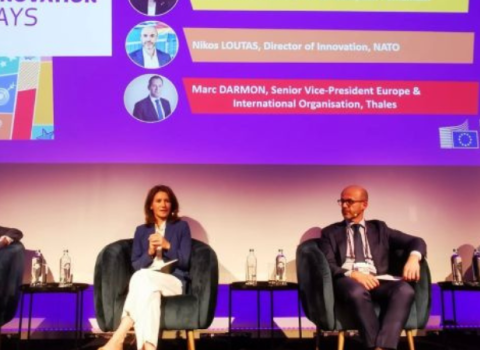In a call for radical change, Thomas Jarzombek, R&D spokesman for the CDU, says the EU should fund challenges where teams compete head to head

Thomas Jarzombek, German parliamentary spokesman for the opposition Christian Democratic Union (CDU) on education, research and technology assessment.
The successor to Horizon Europe should feature more competitions between teams of innovators, with only those that hit early milestones winning full funding, an influential German politician has argued.
With lobbying underway in Brussels over the size and shape of the tenth framework programme, FP10, Thomas Jarzombek, parliamentary spokesman for the opposition Christian Democratic Union (CDU) on education, research and technology assessment, wants a “different risk culture” where the EU is not afraid to yank funding from projects that are not working out.
Jarzombek’s CDU, along with its Bavarian sister party, won last weekend’s European elections and is comfortably leading polls ahead of next year’s federal election, so is likely to be a key voice in shaping FP10, which starts in 2028.
Currently, competition for money in Horizon Europe is fierce at the application writing stage, but once awarded, there is generally little danger of consortia losing it, so long as they report on their progress.
But Jarzombek instead wants competitions where a number of teams that are each trying to achieve a single research or technology goal are whittled down milestone by milestone until only one or a handful are left and then receive full funding to complete the project. Competitions and procurement contracts should, in some areas, replace grants, he says.
“If you have 10 teams going 10 different ways, the opportunity to achieve is much better than to take all the budget [and give it to] only one,” he told Science|Business.
This competitive approach is how Germany’s recently established innovation agency Sprin-D works, and Jarzombek wants FP10 to copy this approach.
“If you're in competition and have these milestones, and you see work by your competitors, you always have to fear that your company will be closed,” he said. This spurs people to go the “extra mile” and make decisions in days, not the years that it sometimes takes in public projects, he said.
The archetypal example of this kind of competition comes from the US, where in 2004 the US Defense Advanced Research Projects Agency (Darpa) offered $1 million to any team that could develop a self-driving car that could cross 300 miles of Mojave Desert. This grand challenge is seen as one of the formative events in the self-driving car industry.
Launcher competitions
Jarzombek’s enthusiasm for competitions stems in part from his role as the German government’s aerospace coordinator from 2017-21.
Learning from the US’s National Aeronautics and Space Administration, the German Space Agency ran a competition among start-ups to build small-scale launchers, with the winners receiving hefty state contracts to actually take a payload into orbit.
“They were very successful with this strategy to say okay, we don't build a rocket by giving one company a big budget. We make a competition between several companies,” he said.
The competition defined performance milestones that each company had to hit before advancing to the next round, creating a kind of “funnel” that ended up with the most promising projects.
Jarzombek also points to Alzheimer’s disease as a very different research field where more competition could help.
While some Alzheimer’s drugs have recently been approved in the US, they only moderately slow the disease, and the underlying causes are still not fully understood. Some scientists argue the Alzheimer’s research community bet everything on one theory, focusing on the build-up of plaques of amyloid beta peptides at the expense of other approaches.
“They all went in the same way, developing medicine in the same way,” he said. “And obviously, it didn’t work out.”
Start-ups versus champions
Above all, Jarzombek wants FP10 to be chock full of active competitions to build new technologies between multiple companies – and for there to be real consequences for failure, like the withdrawal of funding.
But in some respects, this might put him at odds with French and German leadership, and his own party.
At a summit last month, French president Emmanuel Macron and German chancellor Olaf Scholz agreed that there was a need to alter competition rules to “allow for establishing consortia and consolidation in key sectors (eg, mobile network sector, airspace) in order to strengthen European resilience.”
In other words, to form pan-European champions, like Airbus, capable of challenging international rivals. The CDU itself is also in favour of big new public-private consortia, and hails Airbus as a big success story.
But Jarzombek thinks trying to create single European champions is a “big mistake.”
“In Europe, especially from the French side, we often hear that Europe is too small for more than one player,” he said. On the contrary, “we need, in every field, more than one player.”
Basic research protected
Although he wants cut-throat competition at higher technology levels in FP10, Jarzombek also stresses that curiosity-driven, basic research must be protected and expanded.
“It’s really key,” he said. “Important from my point of view is to expand the budget for basic research.”
A focus on impact and project milestones would “destroy” the quality of basic research, he said. On the contrary, basic researchers need “more freedom, more budget, more possibilities – don’t disturb them with anything,” he said.
Dual use research
The other big question hanging over FP10 is whether it will allow dual-use research projects that have potential military applications. Currently, Horizon Europe is civilian only, but the European Commission has opened a consultation on whether to overturn this restriction for its successor.
In the face of the potential threat to Europe from Russia, Jarzombek confirmed that he and his party are “absolutely” behind allowing dual-use research in the successor to Horizon Europe,
“It's obvious that Putin will not stop in Ukraine,” he said. Europe needs to “be prepared, if they come.”
Not just this, but he wants Europe to emulate the US and use military procurement budgets to channel money into dual-use R&D.
In particular, Jarzombek wants Sprin-D to run innovation competitions for the country’s military and federal defence ministry.
“That would really be a game changer,” he said. “We can enable more money for R&D than we have today.”
Sprin-D, which was given more freedom to operate independently of politicians earlier this year, is already funding dual-use innovation challenges, for example in fully autonomous flight, which could be used on the battlefield, a spokesman said.
However, Germany’s coalition government is still developing a national position on whether FP10 should be open to dual-use research.
Some German respondents to the Commission’s consultation are thought to have expressed concerns about the proposed changes, although the head of the Helmholtz Association of research institutions has given them a cautious welcome.
If dual-use is allowed, there is a risk that means less money for civilian R&D, Ruppert Stüwe, a lawmaker who sits on the parliamentary committee for education, research and technology assessment for the governing Social Democratic Party, has warned.
Stüwe is also worried that if German universities and research institutions start contracting heavily for the German military, it could limit their options to collaborate with international partners. He’s also sceptical about the evidence of promised spillover effects, whereby military boosts civilian research and vice versa.
However, Bettina Stark-Watzinger, Germany’s science minister, who comes from the Free Democratic Party, has publicly advocated for more cross-over between civil and military research.





 A unique international forum for public research organisations and companies to connect their external engagement with strategic interests around their R&D system.
A unique international forum for public research organisations and companies to connect their external engagement with strategic interests around their R&D system.